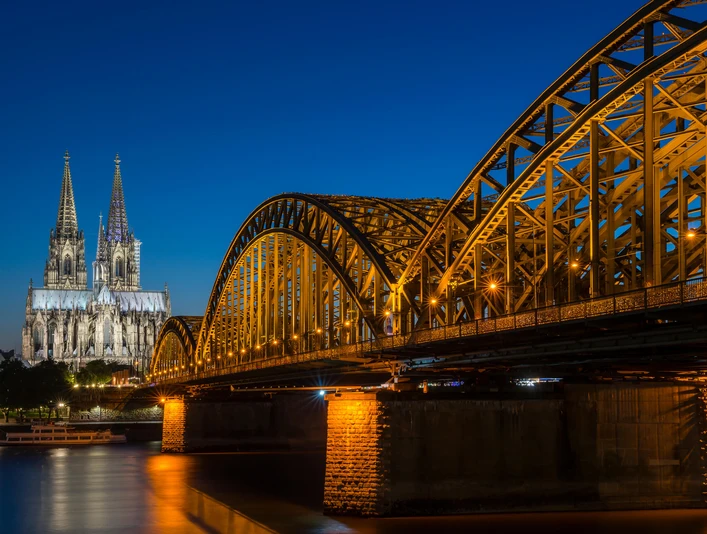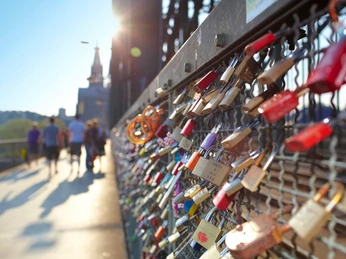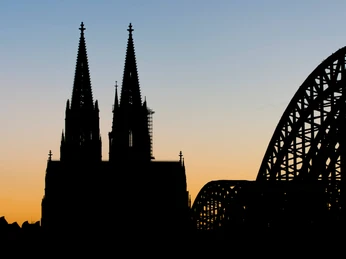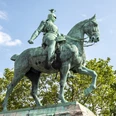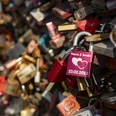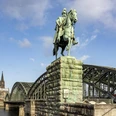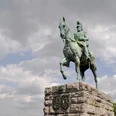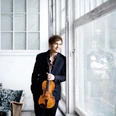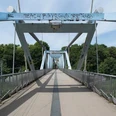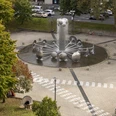With a length of over 400 metres, the Hohenzollern Bridge is a mighty steel structure that stretches powerfully across the Rhine. If you’re a pedestrian, an almost sublime moment awaits you when you cross the bridge along with heavy railway carriages. As you walk, you’ll pass by the thousands upon thousands of love locks for which the Hohenzollern Bridge is famous today.
A stroll across the Hohenzollern Bridge: to Deutz and back
The footpath for this interesting stroll begins directly behind the Museum Ludwig and the Philharmonic Hall. From the other side, i.e. from Deutz, you can enjoy a panoramic view of Cologne’s city centre — with the Hohenzollern Bridge and the Cathedral behind it — as well as a view of Cologne’s Old Town to the left.The Hohenzollern Bridge is one of the most important railway bridges in Germany and one of the hallmarks of Cologne. In addition, thanks to its illumination in the evening and Cologne Cathedral in the background, the Hohenzollern Bridge in Cologne is one of the city’s best-known photo motifs.
Resilience is required: 1,500 train crossings per day
In the past, the bridge was also designed for road traffic, but today only trains, pedestrians and bicycles pass over it. In conjunction with Cologne’s main station, the bridge is one of the most important hubs for German rail traffic. As Germany’s busiest railway bridge it experiences around 1,500 train crossings a day and thus vibrates impressively.The construction history and general history of the Hohenzollern Bridge
The Hohenzollern Bridge was built from 1907 to 1911 and inaugurated by Emperor Wilhelm II. It consisted of three side-by-side truss arch bridges, each with three arches, which have become characteristic of German steel structures and bridge building. Its pillars are made of reinforced concrete, the arches of steel. The bridge has a total weight of 24,000 tonnes.The original equestrian statues have been preserved
While one part of the bridge was reserved for road traffic and trams, the other two carried railway tracks. The access ramps were flanked by equestrian statues of Prussian kings and emperors from the House of Hohenzollern. They have been preserved. Next to the Museum Ludwig stands the equestrian statue of Emperor Wilhelm II, who as a friend of architecture promoted the construction of the bridge. Unfortunately, the original portal structures and towers of the Hohenzollern Bridge no longer exist.On the Deutz side of the bridge you can also still see the historical tracks embedded in the cobblestones. They date back to the era when cars and trams were allowed to pass over the Hohenzollern Bridge.
The Hohenzollern Bridge: destruction and reconstruction
The Hohenzollern Bridge is the only bridge in Cologne that was not destroyed by bombs during World War II. However, on March 6, 1945, the German army blew up the bridge to make it difficult for the Allies to cross the Rhine.After the war, only one of the railway bridges was rebuilt for rail traffic and opened in 1948. Two more truss arch bridges were added between 1956 and 1959, and from 1986 to 1987 respectively. Today, the Hohenzollern Bridge is a six-track railway bridge with a path for pedestrians and cyclists.
The predecessor of the Hohenzollern Bridge: the “Muusfall” (Mousetrap)
People have always needed some way to cross the Rhine. Before the Hohenzollern Bridge, there was the Cathedral Bridge, and before that, people crossed the river in ferryboats or the suspenseful “flying bridges” — a type of cable ferry known as a reaction ferry that takes advantage of the flow energy of a river. Even further back, there was a Roman bridge as early as the fourth century A.D.The Cathedral Bridge, the immediate predecessor of the Hohenzollern Bridge, was built between 1855 and 1859 in order to make rail traffic across the Rhine possible as well. Incidentally, Cologne’s main railway station was also built during this period. Because of its cage-like lattice construction and the lockable gates at the bridgeheads, the Cathedral Bridge was locally known as the Muusfall, or Mousetrap. As rail traffic increased, the Cathedral Bridge with its two tracks was eventually unable to cope. The Hohenzollern Bridge finally replaced the Cathedral Bridge — and became, as noted above, one of Cologne’s most popular photo motifs.
Good to know
Eligibility
for Groups
for Class
for families
for individual guests
Suitable for Pushchair
Payment methods
Directions & Parking facilities
General information
Parking Available
Bus stop available
Our recommendations
Nearby
